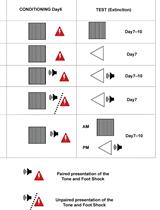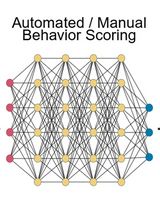- EN - English
- CN - 中文
Sensitive Estimation of Flavor Preferences in STFP Using Cumulative Time Profiles
使用累积时间曲线对STFP中的口味偏好进行敏感估计
发布: 2017年11月05日第7卷第21期 DOI: 10.21769/BioProtoc.2601 浏览次数: 7043
评审: Soyun KimAlexandra GrosAnonymous reviewer(s)
Abstract
Social transmission of food preference (STFP) is observed among rodents between a demonstrator and a naïve hungry observer. During social interaction, hungry observer receives information about safety of the food consumed by the demonstrator. This task has been implemented to develop a single trial non-aversive learning task in order to test hippocampus dependent non-spatial memory in rodents. In this protocol, we describe some novel modifications to the conventional STFP protocol and analysis for more sensitive estimation of change in preferences. Using this method, preference trends can be observed for weeks after training, allowing one to probe the role of systems consolidation (SC) in declarative memory that is relatively independent of spatial navigation.
Keywords: Remote memory (遥远记忆)Background
Bennet G Galef Jr. developed STFP based behavior paradigm with rats during 1970’s in order to test memory mechanisms and since then, it has been implemented in various studies with both rats and mice (Galef Jr, 1977; Clark et al., 2002; Wrenn et al., 2003; Ross and Eichenbaum 2006; Smith et al., 2007; Choleris et al., 2011; Lesburguères et al., 2011; Clark, 2012). In case of rodents, the basic premise of this paradigm comes from their natural feeding behavior. Demonstrator mice [DemoMice] find the food that is safe for consumption through trial and error, and soon after consumption, the information for palatable food is shared with other observer mice [ObMice] through social interaction. Such interactions happen at a location situated away from the feeding site where ObMice learn about the safety of consumed food, or more specifically consumed flavor, when it is detected along with certain breath components of the DemoMice (Galef et al., 1988; Choleris et al., 2009). After establishing such flavor-safety association in STFP paradigm, ObMice have been observed to preferably consume the demonstrated flavor (demoFlavor), when given a choice between a novel and a familiar flavor.
Traditionally, the experimental design would involve arriving at the flavor pairs where both flavors are equally palatable during a consumption session with close to 50% preference for each flavor (Galef and Whiskin, 1998). Since the relative palatability of flavors is determined with different set of animals, one does not get any direct information reflecting innate preferences (IP) of experimental animals. After determining relative palatability of the flavor pair, one of these flavors is demonstrated through social interaction and increase in its preference beyond the 50% level is estimated after STFP. However, such a design does not consider the fact that even though average preference of a group of mice could be 50%, there could be individuals with varying native preference and this in turn could bias the interpretations of the result. Our novel design measures the STFP mediated change in preference while considering the native preference of individual animals.
Further, conventional preference estimation involves comparing the weight of food containers recorded before and after the sessions to calculate ‘weight of consumed food’ (WC.F). During a typical STFP testing session with mice, each individual consumes ~1 g and spills the food weighing up to ~5 g from containers weighing close to 100 g (typical weight of the container had to be ~100 g to prevent toppling). Correcting for errors associated with spillage limits the accuracy of WC.F. Consequently, it makes it difficult to detect minor changes in the strength and nature of the flavor-safety associations. Alternatively, we propose and utilize the ‘number of food consumption episodes’ obtained through video analysis as a measure of performance. Using this method, we establish an STFP procedure that is easy to implement and more sensitive. Inherently, such analyses are easy to use and less error prone as compared to weight measure. They utilize more data points and hence they convey more information in comparison to single point measurements such as total weight of consumed food or total time spent during consumption. Since mice consume small amounts over extended time windows, food intake data cannot be used directly for observing variations in rates of food consumption.
Materials and Reagents
- Identical plastic containers (Figures 1A and 1B): Dimensions 6.5 x 4.5 cm, assembled weight ~100 g (Julia Pet Jar 130 ml) (Princeware, catalog number: 9462 )
- Bedding material made from non-uniform corn cobb granules of 3-4 mm average diameter (Spar Cobb, Sagar Industries, Bangalore, India)
- Food vessel: A lid for smaller plastic container was used as food vessel (Figure 1) (Julia Pet Jar 60 ml) (Princeware, catalog number: 9461 )
Note: It is filled with ground flavored food and placed above the bedding material inside the plastic container. The lid of plastic container is closed such that the centers for food vessel and hole in the lid are aligned vertically. - C57/B6 mice (males, 8-12 weeks of age) housed in pairs after weaning until the beginning of habituation sessions. In order to clearly identify observer mice from demonstrators during interaction sessions in our experiments, demonstrator mice are marked with one hole in each ear pinna under general anesthesia after one week of weaning. Animals are separated for individual housing just before first habituation session.12-16 mice per group provide acceptable power during statistical analyses. The mice are reared in 12 h light/dark cycle and all the experiments are conducted during the light-on phase (06:30 AM-18:30 PM). All the procedures involving animals were performed with approval from institute animal ethics committee, IISc Bangalore
Note: One important consideration is co-housing of observer mouse with demonstrator mouse after weaning. In our method, we do not use a wire mesh/screen during social interaction to separate ObMice and demoMice, in order for the mice interaction to resemble their natural setting. To avoid excessive fighting during social interaction, we randomly select two just-weaned mice and co-house them in the same cage for one month. At the age of ~2 months, these mice are separated to be housed individually for further steps of the protocol and one of them is assigned to become a demonstrator for its cage-mate. Social interaction between two familiar male mice may also help in making it more effective for STFP in comparison to interaction with a stranger male. So, it is crucial to collect a large number of mice in comparable age group at the same time. Either observer or demonstrator mouse can be marked by making a hole in their ear pinna in order to identify them correctly after social interaction session. - Mouse food pellets (Nutrilab Rodent Feed, Provimi)
- Powdered condiments as flavoring agents (Cocoa, Cinnamon, Thyme, Basil; SNAPIN herbs and spices, Lotus household product, India)
Note: Source of all the condiments must be consistent from the beginning to the end of the experiment. - 70% ethanol to clean all the components of food apparatus
Note: Ethanol cleaning is carried out a day before the experiment session. All clean components are dried in warm air flow overnight to remove any odor trace from ethanol. - Sodium hypochlorite solution (4% NaOCl solution) (Fisher Scientific, catalog number: SS290-1 )
Note: It is further diluted to make cleaning solution (see Recipes) for removing prevailing odor from the components of food apparatus and animal cages. After each experiment session, all the components of food apparatus are submerged in a cleaning solution for 15-20 min followed by thorough rinsing in tap water. Cleaned components are then air dried and stored in hygienic conditions. - X% ‘Condiment’ flavored food (see Recipes)
- Cleaning solution (see Recipes)
Equipment
- Plier for making metal trays
- Paint for metal trays: white paint if black coat mice are used and vice versa
- Transparent Perspex sheets with holes drilled along short central axis (Figures 1E)
- Aluminum/Tin metal sheet (sized to fit in the test cage): 1-2 mm thickness for making spill-proof trays to hold food containers. The vertical walls of these trays are 2 cm high. Length and breadth of these trays can be adjusted for achieving best fit within the test cage. For our setup, the dimensions were 16 x 13 cm
- Weighing balance: with sensitivity up to 10 mg
- Electronic grinder (Morphy Richards, model: Icon Essentials ) for making powdered food
- Full HD webcam (Logitech, model: C920 ) for multiplexed video monitoring
- Polarizer filter (RG610, RG series color glass filters, Optica, Optics India; it is optional) to avoid reflections from transparent Perspex sheets covering the test-cages
- Webcam mounting assembly: We used a long wooden stick (300 x 10 x 5 cm3) with a hole at the center along its length and an M6 screw to fix the webcam above test-cage assembly
- Individually ventilated cages (IVCs)/polycarbonate cages for individual housing of mice (IVC; 36 long x 14 wide x 12.5 cm high) (Citizen Industries, catalog number: 11 )
- Portable electronic drill (Robert Bosch, model: Bosch GSB 10 RE Professional ) with drill bits to make holes of 1 cm diameter in the lids of food container
Software
- Free, open source media player such as VLC. Any software for position tracking may also be implemented for estimating time spent near food containers
- Origin software
- Microsoft Excel
- ImageJ plugins (such as Analyze particle)
Procedure
文章信息
版权信息
© 2017 The Authors; exclusive licensee Bio-protocol LLC.
如何引用
Singh, A. and Balaji, J. (2017). Sensitive Estimation of Flavor Preferences in STFP Using Cumulative Time Profiles. Bio-protocol 7(21): e2601. DOI: 10.21769/BioProtoc.2601.
分类
神经科学 > 行为神经科学 > 学习和记忆
您对这篇实验方法有问题吗?
在此处发布您的问题,我们将邀请本文作者来回答。同时,我们会将您的问题发布到Bio-protocol Exchange,以便寻求社区成员的帮助。
Share
Bluesky
X
Copy link













